Abstract
In this study, electrically insulating polyolefin elastomer (POE)-based phase change materials (PCMs) comprising alumina (Al2O3) and graphene nanoplatelets (GNPs) are prepared using a conventional injection moulding technique, which exhibits promising applications for solar energy storage due to the reduced interfacial thermal resistance, excellent stability, and proficient photo-thermal conversion efficiency. A synergistic interplay between Al2O3 and GNPs is observed, which facilitates the establishment of thermally conductive pathways within the POE/paraffin wax (POE/PW) matrix. The in-plane thermal conductivity of POE/PW/GNPs 5 wt%/Al2O3 40 wt% composite reaches as high as 1.82 W m−1K−1, marking a remarkable increase of ≈269.5% when compared with that of its unfilled POE/PW counterpart. The composite exhibits exceptional heat dissipation capabilities, which is critical for thermal management applications in electronics. Moreover, POE/PW/GNPs/Al2O3 composites demonstrate outstanding electrical insulation, enhanced mechanical performance, and efficient solar energy conversion and transportation. Under 80 mW cm−2 NIR light irradiation, the temperature of the POE/PW/GNPs 5 wt%/Al2O3 40 wt% composite reaches approximately 65 °C, a notable 20 °C improvement when compared with the POE/PW blend. The pragmatic and uncomplicated preparation method, coupled with the stellar performance of the composites, opens a promising avenue and broader possibility for developing flexible PCMs for solar conversion and thermal storage applications.
1. Introduction
As electronics and energy storage devices become more tightly packed, high-performance thermal interface materials (TIMs) are gaining attention [1,2,3]. Overheating leads to the decline of performance, reduced lifespan, and safety risks due to a sudden increase in internal heat flux. To ensure safety within a temperature range, it is vital to advance the development of effective materials and technologies for thermal management to ensure the prompt dissipation of accumulated heat. Moreover, given the pressing issues and concerns relating to the population growth, the environment, and energy challenges, the demand for eco-friendly energy has intensified [4,5,6].
Phase change materials (PCMs) are used to store energy and release excess heat during phase changes, making them a key component of thermal management and storage [4,7,8,9]. In general, PCMs mainly include organic PCMs and inorganic PCMs [10]. Compared with inorganic PCMs, organic PCMs have a low supercooling degree, high storage density, and no corrosivity, making them more widely used in industrial sectors [4]. Paraffin wax (PW), which is recognized for its versatility as an organic material, is highly valued for its capacity to adjust its phase change temperature, substantial latent heat capacity, and cost effectiveness [11,12,13]. These attributes make it applicable across various thermal management domains, such as solar energy, electronics, and power batteries. However, during practical use, PW-based phase change composites (PWPCMs) face substantial challenges, exhibiting an inherent low thermal conductivity, potential leakage, inefficient light-to-heat conversion, and lack of flexibility, which decreases the efficiency of thermal storage devices [14]. To overcome these challenges, flexible PCMs are developed through methods like encapsulation with elastic shells, incorporating flexible porous structures, and forming polymer networks [15]. Various polymers like unsaturated polyester resin, polymethyl methacrylate, polyvinyl chloride, and thermoplastic elastomer have been used [16,17,18,19,20]. Yang et al. [21] found that using a melamine sponge with excellent elasticity enhanced stability and thermal conductivity. Bing et al. [22] created a UPR/EG/PEG composite that could be used for solar energy applications, and it was found effective in absorbing sunlight, converting photo-thermal energy, and energy storage. However, flexible PCMs that include polymer-supporting structures experience sluggish thermal response due to the low thermal conductivity of organic solid-liquid PCMs.
Researchers have adopted diverse approaches, including utilizing carbon-based materials, metallic fillers, and inorganic ceramic fillers such as MXene, graphite, graphene nanoplatelets (GNPs), carbon nanotubes (CNTs), silver particles, silver nanowires, and spherical alumina (Al2O3) to enhance the photo-thermal conversion and the thermal conductivity of PCMs [23,24]. For example, Qi et al. [25] constructed a PCM that consisted of graphene foam and PW (i.e., GF/PW), which had a three-dimensional (3D) network, giving it excellent shape stability and a high thermal energy storage density. Notably, it demonstrated a remarkable 87% enhancement in thermal conductivity and an 89% improvement in solar-thermal conversion efficiency. Wei et al. [3] employed a simple physical blending method to integrate GNPs as thermal conductive fillers into a cross-linked polyolefin elastomer (POE), resulting in flexible PCMs with a thermal conductivity of about ∼5.11 W m−1K−1 and a notable capacity for efficient solar-thermal conversion. Ishida and Rimdusit [26] achieved a thermal conductivity as high as 32.5 W m−1K−1 in a polybenzoxazine composite containing boron nitride (BN) at a filler concentration of 78.5 vol% (88 wt%). Despite the improved thermal conductivity, the mechanical properties were compromised due to the formation of defects at the polymer–filler interface, which negatively affected the phonon transport and mechanical properties [27]. The observed decline in mechanical properties after filler addition is consistent across various flexible PCMs, posing a challenge to effectively improve thermal conductivity while preserving favorable mechanical properties.
Numerous studies showed that incorporating hybrid fillers improved the performance of functional fillers in polymer composites, enhancing properties like electromagnetic interference shielding [28,29], wave absorption [30,31], electrical conductivity [32], and thermal conductivity [33]. Ren et al. [34] observed enhancements in both mechanical properties and thermal conductivity of polypropylene (PP) through the addition of GNPs. Jin et al. [35] reported an increase in the thermal conductivity of polycarbonate (PC) from 0.19 to 1.42 W m−1K−1 by adding 20 wt% BN, 1 wt% GNPs, and 1 wt% CNTs. Although significant research progress has been achieved, there remains a lack of comprehensive understanding regarding hybrid fillers in preparing functional polymer composites. Developing PCMs with latent heat and concurrently improving mechanical strength, light-to-heat conversion, and heat transport is necessary to overcome obstacles for experimental design. Further investigation is essential to uncovering the intricate relationship between the structure and performance of PCMs.
In this study, a series of POE/PW/GNPs/Al2O3 PCMs were prepared using an injection moulding technique. The mechanical strength, flexibility, thermal conductivity, and efficiency in converting light to heat were systematically studied. Additionally, the investigation delved into detailed analyses of morphology, structure, crystallization, thermal stability, and simulated thermal management scenarios. The objective is to develop flexible PCMs with noteworthy thermal conductivity, large latent heat storage, effective light-heat conversion, and high tensile strength. This work aimed to enable integrated functionalities such as photothermal conversion, efficient heat storage, and versatile utilization in various thermal management applications. The proposed method provides a facile method to prepare PCMs with enhanced performance that show promising applications in the energy storage, solar utilization, and advanced thermal management sectors.
2. Materials and Methods
2.1. Materials
Paraffin wax (PW), with an apparent density of 0.90 g cm−3, was obtained from China Sinopharm Group, Beijing, China. Polyolefin elastomer (POE), commercially known as 3980, was provided by ExxonMobil Chemical Co., Ltd., Spring, TX, USA, and it has a density of 0.89 g cm−3. Graphene nanoplatelets (GNPs), with a thickness of 4~20 nm and filler size ranging from 5~10 μm, were supplied by Chengdu Institute of Organic Chemistry, Chengdu, China. Spherical alumina (Al2O3), with an average particle size of 20 μm, was purchased from Tianxing New Materials Technology Co., Ltd., Xiaoyi, China.
2.2. Sample Preparation
Prior to blending, POE pellets, Al2O3, and GNPs were dried at 60 °C for at least 10 h. After this, a sequence of POE/PW/GNPs/Al2O3 composites were meticulously formulated through melt blending, employing an internal mixer (XSS-300) at 90 °C and 50 rpm for 5 min. The specific formulations for the prepared samples are tabulated in Table 1. Afterwards, the resulting mixtures were pulverized using a grinder, and they were used for injection moulding using a Thermo Scientific HAAKE Minijet apparatus (Waltham, MA, USA). The injection pressure was set at 500 bar, and the volumetric flow rate was about 3.0 cm3 s−1. The dimensions of the samples were 80 × 10 × 4 mm3 (length × width × thickness), and the mold temperature was 40 °C.

Table 1.
Formulations of flexible PCMs.
2.3. Characterization
2.3.1. Differential Scanning Calorimetry (DSC)
To analyze the melting and crystallization behavior of the flexible phase change materials (FPCMs), a differential scanning calorimeter (DSC, TGA/DSC-1, Mettler Toledo, Zürich, Switzerland) was employed. Samples, weighing 5~8 mg, were heated to 200 °C at 10 °C min−1, and they were held at 200 °C for 5 min to eliminate thermal history. Subsequently, samples were cooled down to 40 °C at 10 °C min−1. All tests were carried out in a nitrogen (N2) atmosphere.
2.3.2. Thermal Conductivity
The thermal diffusivity (α) of samples was determined by a laser flash method using a Discovery DXF-900 instrument (TA Instruments, New Castle, PA, USA). To determine the thermal conductivity (λ) of FPCMs, the following equation was employed: λ = α × Cp × ρ, where ρ is density [36]. Here, α and Cp denote the thermal diffusivity and specific heat capacity, respectively.
The bulk density was measured using the water displacement method with the help of an MH-120E apparatus (Matsu Haku, Taiwan, China). The Cp was determined by DSC using sapphire as the reference.
2.3.3. Scanning Electron Microscope (SEM)
The morphology of FPCMs was observed using a scanning electron microscope (SEM, Nova Nano 450, FEI, Hillsboro, OR, USA). The samples were cryo-fractured in liquid nitrogen, followed by coating a thin layer of gold to enhance image resolution.
2.3.4. Electrical Conductivity
A high-resistance meter (model TH2684A, Changzhou Tonghui Electronics Co., Ltd., Changzhou, China) was used to evaluate the electrical conductivity (σ) of FPCMs. The testing range of the electrometer ranged from 10 kΩ to 100 TΩ. The values of σ for samples were determined using Equation (1) [37]:
where, ρ is electrical resistivity, L is the distance between the copper electrodes, R is the volume resistance, and S is the cross-sectional area.
σ = 1/ρ = L/RS
2.3.5. Viscoelastic Behavior
To delve into the viscoelastic properties, a dynamic rheometer (MCR302, Anton Paar, Graz, Austria) was employed at a temperature of 90 °C. Analyses were performed using a constant-strain mode with a strain rate of 1%. To investigate the storage modulus (G′), viscous modulus (G″), and complex viscosity (η*) at various frequencies ranging from 100 to 0.01 rad s−1, specimens with a diameter of 25 mm and thickness of 1 mm were employed.
2.3.6. X-ray Diffraction (XRD)
The crystalline structure and diffraction characteristics of FPCMs were studied using X-ray diffraction using an X-ray diffractometer (XRD, X’Pert Pro, PANalytical, Almelo, The Netherlands). The diffraction patterns were collected within a 2θ range of 5~60° at 5° min−1.
2.3.7. Mechanical Properties
The mechanical properties of FPCMs were assessed using an Instron 4302 universal mechanical tester (Instron Co., Canton, MA, USA). The crosshead speed was 50 mm min−1.
2.3.8. Light-to-Energy Conversion and Energy Storage
The energy transformation from light to electricity was accomplished with the assistance of a CELHXUV300 xenon lamp (CEAULIGHT, Beijing, China) and an AM 1.5 filter, along with a CEL-NP2000 optical power meter and a Seebeck thermoelectric device at 25 °C. A Keithley electrometer (2400, Cleveland, OH, USA) was utilized to record real-time voltage data.
2.3.9. Light-to-Temperature Energy Conversion
The energy conversion from light to temperature was conducted using a CELHXUV300 xenon lamp (CEAULIGHT, China) equipped with an AM 1.5 filter, a CEL-NP2000 optical power meter (CEAULIGHT, China), and a real-time temperature detector (TA612A, TASI, Suzhou, China). The samples were positioned within a foam insulation system, and the lamp’s simulated sunshine was radiated directly on the surface of samples. The light intensity was measured and adjusted using an optical power meter (CEL-NP2000, Beijing Zhongguo Jinyuan Science and Technology Co., Ltd., Beijing, China) to ensure accuracy. The calibration procedure allowed for exact control and measurement of light intensity during light-to-temperature energy conversions, providing vital insights into the performance of FPCMs under various lighting circumstances.
3. Results and Discussion
3.1. Rheological Properties
The flowability of composites plays a crucial role in the injection moulding process, which affects the filling properties and microstructural evolution of the products [24,38]. To investigate the effect of adding Al2O3 and GNPs on the flowability of POE/PW composites, the rheological properties of the composites were tested. Figure 1 presents the frequency-dependent viscoelastic properties of the POE/PW/Al2O3/GNPs composite, including storage modulus (G′), loss modulus (G″), and complex viscosity (η*). Figure 1a,b indicate that introducing PW into the POE significantly reduces the values of both G′ and G″, revealing that the elasticity of the POE/PW composites is enhanced. However, adding Al2O3 and GNPs into POE/PW composites displays a reverse phenomenon, in which the G′ and G″ increases with the presence of inorganic fillers. The above revealed that the added fillers had a reinforcing effect on the POE/PW composites. Moreover, the η* of all samples exhibits a gradual decrease with increasing shear frequency within the entire frequency range, known as the “shear thinning” phenomenon [39]. As shown in Figure 1c, all composites exhibit a plateau where the η* of the composites does not change with an increase in a low-frequency region, indicating that the composites possess the characteristics of non-Newtonian fluids. Whereas the η* of the composites decreases with further increasing angular frequency, exhibiting the phenomenon of Newtonian fluid. Nevertheless, the η* for samples containing fillers demonstrates an increase with the incorporation of Al2O3 and GNPs. The results suggest that the addition of fillers impairs the mobility of polymer melts, causing an increase in η*. It is noteworthy that the η* of the composites is consistently lower than pure POE, indicating enhanced flowability and processability.

Figure 1.
(a) Storage modulus (G′), (b) loss modulus (G″), and (c) complex viscosity (η*) of POE/PW and POE/PW/GNPs/Al2O3 composites as a function of frequency at 90 °C.
3.2. Morphology
Figure 2 displays the SEM images illustrating the cross-sectional view of FPCMs. The PW exhibits a dense morphology, and the PW of spherical shapes that are irregular and vary in size are tightly integrated into a composite structure of POE. The irregular spherical shape of PW was attributed to the difference in the wettability between the POE and PW. In Figure 2b, it is evident that the addition of GNPs effectively improves the distribution of PW, resulting in smaller particle sizes. Interestingly, Figure 2c–g show that the presence of Al2O3 affects neither the morphology nor the structure of PW-based FPCMs. PW is well distributed among the inorganic particles, serving as an effective connector and contributing to enhancing the mechanical properties of the composites.
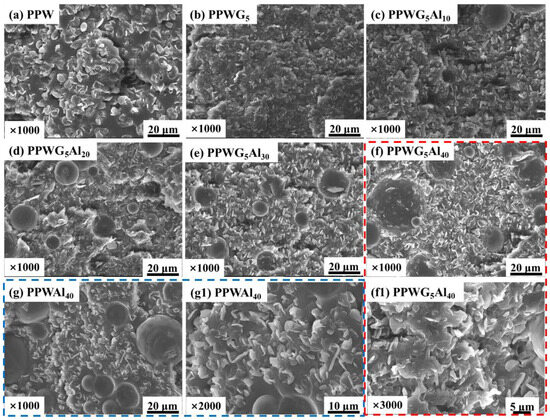
Figure 2.
SEM images of FPCMs, in which (f1) and (g1) were the local magnification of (f) and (g), respectively.
3.3. Crystallization Behavior of FPCMs
The XRD patterns of FPCMs are shown in Figure 3a. The characteristic peaks of FPCMs are a combination of the peaks of several components (GNPs, Al2O3, and PW), which proves that the filling process is basically physical mixing. Moreover, compared with pure PPW, the position and intensity of the peaks at 21.4° and 23.8° of FPCMs do not change significantly. This suggests that PW retained its crystalline state within FPCMs, ensuring the effective release of latent heat.
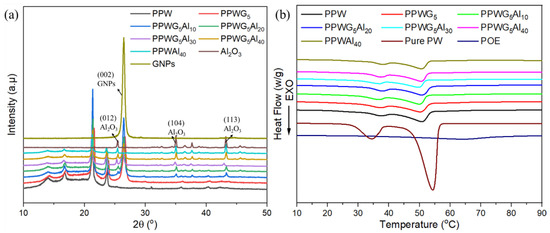
Figure 3.
(a) The XRD curves and (b) DSC curves of FPCMs.
The heat storage capacity, a critical parameter for FPCMs, was determined by DSC. Figure 3b illustrates the DSC curves for FPCMs with varying Al2O3 loadings. The corresponding results are shown in Table 2. During the melting process, there are two obvious phase transition peaks in the DSC curves of PW, among which, the peak of about 35 °C corresponds to the solid-solid phase transition of PW, and with the further increase in temperature, PW undergoes a solid-liquid phase change; a second endothermic peak appears at about 50 °C, which reflects the good heat storage ability of PW. The DSC curves of FPCMs with different loadings of Al2O3 and GNPs showed highly overlapping patterns, indicating a similar phase transition behavior, with two endothermal peaks appearing during the melting process. This suggested that the presence of Al2O3 and GNPs allowed for a normal phase transition process. However, a slight difference between FPCMs and pure PW was noted in the melting temperature. This is mainly because the cross-linking effect of FPCMs resulted in an expansion of PW particles during the melting process.

Table 2.
The thermal analysis data of DSC.
3.4. Mechanical Properties
The application of FPCMs demands commendable mechanical properties, often presenting a challenge since PW has a high degree of rigidity in the solid state. Typically, the simultaneous improvement of mechanical strength and heat storage properties in FPCMs is considered contradictory. Figure 4a illustrates the stress–strain curves of FPCMs filled with varying amounts of Al2O3, and the results are shown in Figure 4b. Introducing PW into POE proves to be highly effective, significantly enhancing the elongation at break from approximately 650% to around 1100%, representing a twofold improvement. Notably, the PPW, with and without GNPs, demonstrated the ability to withstand tensile stresses of 15.3 and 14.8 MPa, respectively. Correspondingly, the tensile strain reached 930% and 1127%, respectively. The tensile strength and strain of PW-based PCMs demonstrated a regular decrease with increasing Al2O3 loadings. Even at an Al2O3 loading of 40 wt%, FPCMs exhibited a tensile stress of 12 MPa and a strain of 900%. FPCMs with mechanical strength serve as an effective thermal management solution. Despite the irregular distribution of Al2O3 and PW, the cross-linking structures contributed to improving the mechanical strength of FPCMs, enabling a simultaneous enhancement in strong mechanical strength, converting light into heat, and maintaining latent heat.
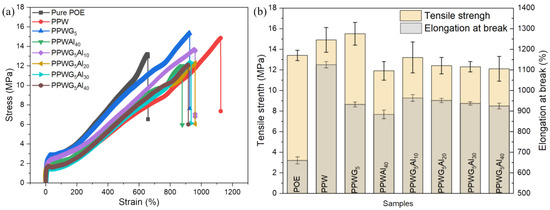
Figure 4.
(a) Stress–strain curves of FPCMs and (b) the corresponding average data.
3.5. Thermal Conductivity
Figure 5a–c depicts the in-plane and through-plane λ as well as the enhancement rate of λ for POE/PW/Al2O3/GNPs composites. The λ of PPW without fillers is poor, with in-plane and through-plane λs of 0.49 and 0.18 W m−1K−1, respectively. The difference in λ between the in-plane and through-plane of PPW is due to the orientation of PPW chains under the action of a shear force field during injection moulding. The λ of PPW increased due to the addition of functional fillers. In particular, the PPWG5 had an in-plane λ of 1.1 W m−1K−1 and a through-plane λ of 0.22 W m−1K−1. This was related to the oriented arrangement of polymer chains that improved the λ by increasing the mean free path of phonons. Figure 5a,b show that the λ of POE/PW/GNPs/Al2O3 in different orientations increases linearly with the increase in Al2O3 content, which suggests that the increase in filler content facilitated the formation of 3D conductive pathways, thereby contributing to an increase in λ. The in-plane and through-plane λs of PPWG5Al40 are 1.42 and 0.38 W m−1K−1, which increased by 269% and 111%, respectively, when compared to pure PPW (Figure 5c). This is mainly due to the complementary shapes of Al2O3 and GNPs, which exert a synergistic effect inside the matrix and significantly improve the λ. Furthermore, the composites have commendable insulating properties, as confirmed by the insulation analysis in Figure 5d. Table 3 shows the λ using similar thermally conductive fillers or phase change materials. It can be noted that this work is the highest in both the values of λ and the degree of increase in λ. This further confirms that the spherical Al2O3 and lamellar GNPs are able to complement each other to exert a synergistic effect within the matrix, which greatly facilitates the construction of the thermal conductive network.
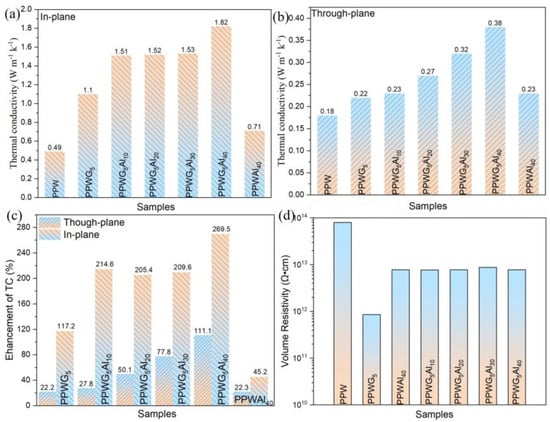
Figure 5.
(a) In-plane and (b) through-plane thermal conductivity (λ) of FPCMs, (c) the enhancement of λ for FPCMs when compared with PPW, and (d) the volume resistivity of FPCMs.

Table 3.
Comparison of thermal conductivity and enhancement rate of thermal conductivity.
The service life of LED lamps decreases exponentially with the increase in operating temperature, and the accumulation of heat causes problems such as wavelength shift and output power reduction. To verify the heat dissipation of thermal management materials, FPCMs with a thickness of 2 mm were placed between the LED chip and heat sink. A temperature recorder and a thermal infrared imager were also used to record the temperature of the LED lamp surface in real time, as shown in Figure 6a,b. The results showed that when using PPW as the thermal management material, the temperature of the LED surface increases gradually with the prolongation of working time, and when the time reaches 270 s, the temperature of the LED surface reaches about 75 °C, since PPW has a lower λ and it is not able to dissipate the heat generated by the LED chip. However, when using POE/PW/GNPs/Al2O3 composites, the temperature of the LED chip shows a slower increase and stays at a relatively low steady state of 77.3 °C (PPWAl40) and 65.2 °C (PPWG5), respectively. A comparison of the data reveals that the PPWG5Al40 has a higher thermal management capability with the concurrent addition of GNPs and Al2O3. The temperature of the LED chip sustained at 56.9 °C, which is about 13 °C higher than that of heat sink. This fully demonstrates that PPWG5Al40 has the best heat dissipation ability, which is consistent with its high λ.
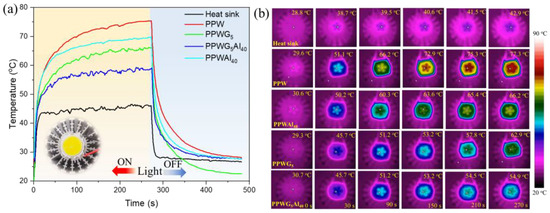
Figure 6.
(a) The temperature variation of LED with time (the temperature of the center of LED chip was measured) and (b) the infrared images of working LED using FPCMs as a thermal management material after 5 min.
3.6. Light-to-Heat Conversion
As shown in Figure 7a, the ability of photo-thermal conversion was evaluated using a homemade device, in which a composite film was placed on a heat sink, and the change in surface temperature was recorded by an infrared thermographic camera under the simulated sunlight. As shown in Figure 7b, the surface temperature of POE/PW/GNPs/Al2O3 increases rapidly at a light density of 80 mW cm−2, and a temperature plateau appears during the heating process. The maximum temperature of PPW as well as PPWAl40 films reaches about 45 °C. However, with the addition of GNPs, the maximum temperature of PPWG5 was substantially increased to 60 °C. Moreover, by introducing Al2O3 into PPWG5, the maximum temperature of PPWG5Aly can be further enhanced. For example, the PPWG5Al40 film shows the fastest heating rate with the highest temperature. Therefore, it can be concluded that GNPs and Al2O3 play a dominant role in photothermal conversion ability. As shown in Figure 7c, the surface temperatures of FPCMs were analyzed at the light intensities of 50, 80, and 120 mW cm−2, respectively, and the surface temperatures of FPCMs increased with the increase in light power. PPWG5Al40 reaches a very high temperature of about 87 °C at a light intensity of 120 mW cm−2.
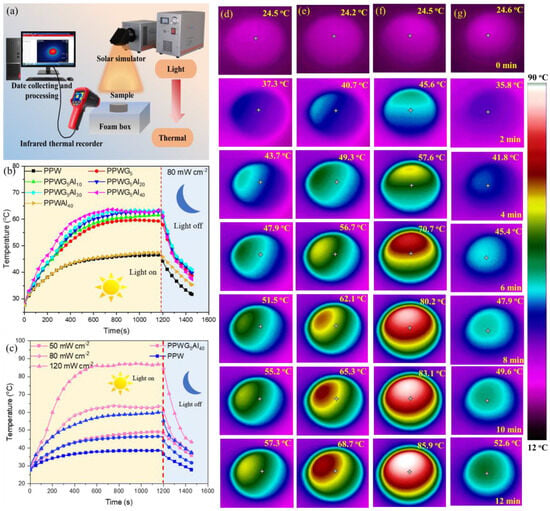
Figure 7.
(a) Illustration of light-to-thermal energy conversion equipment; (b) surface temperatures of FPCMs under various NIR light irradiation; (c) surface temperature changes of FPCMs under 80 mW cm−2 NIR light irradiation and (d–f) the infrared thermal images of PPWG5Al40 composites under 50, 80, and 120 mW cm−2 NIR light irradiation, respectively; and (g) the infrared thermal images of FPCMs under 120 mW cm−2 NIR light irradiation.
To further validate the impact of GNPs and Al2O3 on light-to-thermal conversion performance, an analysis of the surface temperature distribution was conducted using an infrared thermal camera for FPCMs. As depicted in Figure 7d, with an increase in irradiation time, the surface temperature of FPCMs consistently increased. Notably, FPCMs with GNPs and Al2O3 exhibited higher surface temperatures when compared to those without fillers at equivalent irradiation times. Furthermore, a direct correlation was observed between higher sunlight irradiation and the increased surface temperature of FPCMs. For instance, after a 12 min irradiation period, the average surface temperature of PPWG5Al40 at 50, 80, and 120 mW cm−2 reached 57.3, 68.7, and 85.9 °C, respectively. In contrast, the average surface temperature of pure PPW at 120 mW cm−2 was only 52.6 °C. These findings further substantiated that the incorporation of GNPs and Al2O3 effectively enhances the light-to-thermal conversion performance of FPCMs.
The GNPs used in this study enhance the photon-absorbing capacity of FPCMs, allowing them to achieve the energy conversion of light property that graphene has demonstrated, which shows considerable promise for light-driven devices [39]. The “Seeback” thermoelectric device was utilized to construct a light-heat-electricity energy conversion that utilizes PCMs. This system utilizes a “Seeback” thermoelectric device, with a composite PCM and tap water serving as the heat source and cold source for the thermoelectric component, as depicted in Figure 8a. The intensity of the simulated sunshine was precisely regulated to 80 mW cm−2, while a real-time electrostatic meter was employed to measure the voltage. As shown in Figure 8a, the voltage of POE/PW-based composites increases rapidly at a light intensity of 80 mW cm−2, and a clear voltage plateau occurs during the heating process. The maximum voltage of PPW as well as PPWAl40 reaches about 26 and 30 mV, respectively. However, with the addition of GNPs, the maximum voltages of PPWG5 and PPWG5Aly are substantially increased to about 40 mV. Therefore, it can be concluded that the addition of GNPs significantly improves the photo thermoelectric conversion efficiency. As shown in Figure 8b, the photo thermoelectric conversion efficiency of PPWG5Al40, which has the best photo thermoelectric conversion efficiency, is further investigated by analyzing the voltage of the films at light intensities of 50, 80, and 120 mW cm−2, respectively, and the voltage of the films increases with the increase in light power. The PPWG5Al40 achieves a higher voltage of around 45 mV at a light intensity of 120 mW cm−2. It further shows that the photothermal power conversion efficiency of the composite film is better. It is worth mentioning that this work uses tap water as a cold source, and it is close to the actual application scenario.
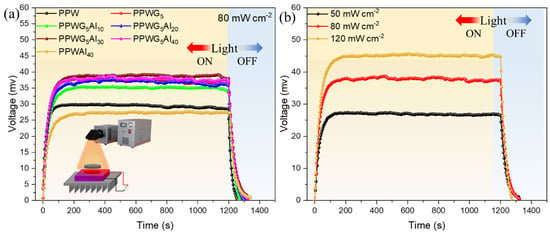
Figure 8.
(a) Light-to-electric conversion and V-t curves of FPCMs under the sunlight irradiation of 80 mW cm−2 and (b) V-t curves of PPWG5Al40 under 50, 80, and 120 mW cm−2, respectively.
3.7. Thermal Cycling Stability of FPCMs
The PPW and PPWG5Al40 were chosen to analyze the changes of crystalline structures undergoing 100 thermal cycles, as shown in Figure 9a. As can be seen from Figure 9a, no new diffraction peaks appeared in the XRD patterns of all samples before and after cycling, indicating that no change in the crystalline structure of the composites occurred. Moreover, the thermal cycling stability of PPWG5Al40 was characterized by DSC, as shown in Figure 9b. From the DSC curves in Figure 9b, it can be seen that the phase transition temperature and enthalpy of PPWG5Al40 did not change significantly after 100 DSC cycles, especially the enthalpy of the phase change basically did not have any loss, which indicates that PPWG5Al40 can still maintain stable thermophysical properties and chemical structure after 100 cycles of elevated/lowered temperatures, and it exhibits excellent cycling stability. To further validate its stability, multiple cyclic tests were performed on the FPCMs under 80 mW cm−2 NIR light irradiation, as displayed in Figure 9d. As can be seen from Figure 9d, the photothermal curves remained unchanged after multiple cycles, indicating that the PPWG5Al40 exhibits good stability.
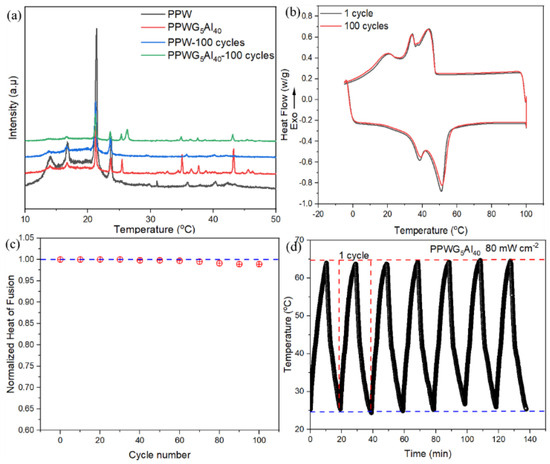
Figure 9.
(a) The XRD patterns of FPCMs and (b) the DSC curves of PPWG5Al40 with 100 thermal cycles, (c) the mass specific heat of fusion normalized by the first heating cycle, and (d) the surface temperature changes of FPCMs under 80 mW cm−2 NIR light irradiation.
4. Conclusions
This work successfully prepared a series of thermal-induced flexible phase change composites (FPCMs) consisting of polyolefin elastomer (POE), paraffin wax (PW), graphene nanoplatelets (GNPs), and aluminum oxide (Al2O3) through blending and injection moulding. The composites exhibited good thermal management, coupled with superior performance in terms of photothermal conversion and heat transfer. A comprehensive analysis was conducted concerning the synergistic contribution of PW and GNPs to enhance the mechanical strength, the conversion of light to heat, and the heat storage capabilities of FPCMs. The underlying mechanism driving this enhancement was thoroughly elucidated. GNPs play a crucial role as photon-absorbing and molecular heaters that are effective under solar irradiation, inducing lattice vibrations in FPCMs, and facilitating efficient light-to-heat conversion. Furthermore, the combination of GNPs and Al2O3 established thermal conduction networks, thereby augmenting the heat transfer ability. The synergistic effect of hybrid fillers resulted in the fabrication of PPWG5Al40 with a tensile strength of 13 MPa, elongation at break of about 900%, in-plane thermal conductivity of 1.82 W m−1K−1, and efficient improvement in light-to-thermal conversion. In addition to exhibiting favorable crystallization properties, FPCMs displayed high light-driven shape recovery capabilities, acceptable thermal stability, and significant temperature control properties. Collectively, these attributes underscore the suitability of these composites for thermal management applications in electronics, among others.
Author Contributions
J.T.: conceptualization, methodology, formal analysis, writing—original draft preparation, project administration, and funding acquisition; K.W. and R.X.: resources and formal analysis; C.W. and X.L.: investigation, data curation, and resources; Q.Y.: conceptualization, writing—review and editing and supervision. All authors have read and agreed to the published version of the manuscript.
Funding
This research was funded by the Project of Basic Research Programme of Shaanxi Provincial Department of Education (No. 21JK0571).
Institutional Review Board Statement
Not applicable.
Informed Consent Statement
Not applicable.
Data Availability Statement
Data are contained within the article.
Conflicts of Interest
The authors declare no conflicts of interest. The funders had no role in the design of the study; in the collection, analyses, or interpretation of data; in the writing of the manuscript; or in the decision to publish the results.
References
- Feng, C.P.; Bai, L.; Shao, Y.; Bao, R.Y.; Liu, Z.Y.Y.; Yang, M.B.; Chen, J.; Ni, H.Y.; Yang, W. A Facile Route to Fabricate Highly Anisotropic Thermally Conductive Elastomeric POE/NG Composites for Thermal Management. Adv. Mater. Interfaces 2018, 5, 1700946. [Google Scholar] [CrossRef]
- Wang, J.; Li, W.; Zhang, X. An Innovative Graphene-based Phase Change Composite Constructed by Syneresis with High Thermal Conductivity for Efficient Solar-Thermal Conversion and Storage. J. Mater. Sci. Technol. 2024, 178, 179–187. [Google Scholar] [CrossRef]
- Bai, Y.; Shi, Y.; Zhou, S.T.; Zou, H.W.; Liang, M. A Concurrent Enhancement of Both In-Plane and Through-Plane Thermal Conductivity of Injection Molded Polycarbonate/Boron Nitride/Alumina Composites by Constructing a Dense Filler Packing Structure. Macromol. Mater. Eng. 2021, 306, 2100267. [Google Scholar] [CrossRef]
- Bing, N.; Wu, G.; Yang, J.; Chen, L.; Xie, H.; Yu, W. Thermally Induced Flexible Phase Change Composites with Enhanced Thermal Conductivity for Solar Thermal Conversion and Storage. Sol. Energy Mater. Sol. Cells 2022, 240, 111684. [Google Scholar] [CrossRef]
- Zhang, Y.; Wang, J.; Qiu, J.; Jin, X.; Umair, M.M.; Lu, R.; Zhang, S.F.; Tang, B.T. Ag-Graphene/PEG Composite Phase Change Materials for Enhancing Solar-Thermal Energy Conversion and Storage Capacity. Appl. Energy 2019, 237, 83–90. [Google Scholar] [CrossRef]
- Su, T.Y.; Liu, N.S.; Lei, D.D.; Wang, L.X.; Ren, Z.Q.; Zhang, Q.X.; Su, J.; Zhang, Z.; Gao, Y.H. Flexible MXene/Bacterial Cellulose Film Sound Detector Based on Piezoresistive Sensing Mechanism. ACS. Nano 2022, 16, 8461–8471. [Google Scholar] [CrossRef] [PubMed]
- Zhang, C.; Zheng, X.; Fang, Y.; Zhang, Z.; Gao, X.; Xie, N. Flexible Composite Phase Change Materials with Enhanced Thermal Conductivity and Mechanical Performance for Thermal Management. J. Energy Storage 2023, 11, 18832–18842. [Google Scholar]
- Lin, Y.; Kang, Q.; Liu, Y.; Zhu, Y.; Jiang, P.; Mai, Y.W.; Huang, X. Flexible, Highly Thermally Conductive and Electrically Insulating Phase Change Materials for Advanced Thermal Management of 5G Base Stations and Thermoelectric Generators. Nano-Micro Lett. 2023, 15, 31. [Google Scholar] [CrossRef] [PubMed]
- Tang, X.; Deng, J.; Wu, Z.; Li, X.; Wang, C. Experimental Investigation on BN-based Flexible Composite Phase-Change Material for Battery Module. Front. Energy Res. 2022, 10, 801341. [Google Scholar] [CrossRef]
- Tang, Z.D.; Gao, H.Y.; Chen, X.; Zhang, Y.F.; Li, A.; Wang, G. Advanced multifunctional composite phase change materials based on photo-responsive materials. Nano Energy 2021, 80, 105454. [Google Scholar] [CrossRef]
- Li, X.; Chen, H.; Liu, L.; Lu, Z.; Sanjayan, J.G.; Duan, W.H. Development of Granular Expanded Perlite/Paraffin Phase Change Material Composites and Prevention of Leakage. Sol. Energy 2016, 137, 179–188. [Google Scholar] [CrossRef]
- Gulfam, R.; Zhang, P.; Meng, Z. Advanced Thermal Systems Driven by Paraffin-Based Phase Change Materials—A Review. Appl. Energy 2019, 238, 582–611. [Google Scholar] [CrossRef]
- Zhang, H.; Liu, Z.; Mai, J.; Wang, N.; Zhang, N. Super-Elastic Smart Phase Change Material (SPCM) for Thermal Energy Storage. Chem. Eng. J. 2021, 411, 128482. [Google Scholar] [CrossRef]
- Kou, Y.; Sun, K.; Luo, J.; Zhou, F.; Huang, H.; Wu, Z.S.; Shi, Q. An Intrinsically Flexible Phase Change Film for Wearable Thermal Managements. Energy Storage Mater. 2021, 34, 508–514. [Google Scholar] [CrossRef]
- Shi, J.; Qin, M.; Aftab, W.; Zou, R. Flexible Phase Change Materials for Thermal Energy Storage. Energy Storage. Mater. 2021, 41, 321–342. [Google Scholar] [CrossRef]
- He, L.; Wang, H.; Yang, F.; Zhu, H. Preparation and Properties of Polyethylene Glycol/Unsaturated Polyester Resin/Graphene Nanoplates Composites as Form-Stable Phase Change Materials. Thermochim. Acta 2018, 665, 43–52. [Google Scholar] [CrossRef]
- Zhou, S.T.; Yu, L.; Song, X.; Chang, J.; Zou, H.W.; Liang, M. Preparation of Highly Thermally Conducting Polyamide 6/Graphite Composites via Low-Temperature In Situ Expansion. J. Appl. Polym. Sci. 2013, 131, 131. [Google Scholar] [CrossRef]
- Tang, Y.; Lin, Y.X.; Jia, Y.T.; Fang, G.Y. Improved thermal properties of stearyl alcohol/high density polyethylene/expanded graphite composite phase change materials for building thermal energy storage. Energy Build. 2017, 153, 41–49. [Google Scholar] [CrossRef]
- Tao, Z.; Chen, X.; Yang, M.; Xu, X.; Wang, G. Three-Dimensional rGO@ Sponge Framework/Paraffin Wax Composite Shape-Stabilized Phase Change Materials for Solar-Thermal Energy Conversion and Storage. Sol. Energy Mater. Sol. Cells 2020, 215, 110600. [Google Scholar] [CrossRef]
- Chen, Y.; Zhao, L.; Shi, Y. Preparation of Polyvinyl Chloride Capsules for Encapsulation of Paraffin by Coating Multiple Organic/Inorganic Layers. J. Taiwan. Inst. Chem. Eng. 2017, 77, 177–186. [Google Scholar] [CrossRef]
- Yang, J.; Jia, Y.L.; Bing, N.C.; Wang, L.L.; Xie, H.Q.; Yu, W. Reduced Graphene Oxide and Zirconium Carbide Co-Modified Melamine Sponge/Paraffin Wax Composites as New Form-Stable Phase Change Materials for Photothermal Energy Conversion and Storage. Appl. Therm. Eng. 2019, 163, 114412. [Google Scholar] [CrossRef]
- Bing, N.; Yang, J.; Gao, H.; Xie, H.; Yu, W. Unsaturated Polyester Resin Supported Form-Stable Phase Change Materials with Enhanced Thermal Conductivity for Solar Energy Storage and Conversion. Renew. Energy 2021, 173, 926–933. [Google Scholar] [CrossRef]
- Li, X.; Sheng, X.; Fang, Y.; Hu, X.; Gong, S.; Sheng, M.; Qu, J. Wearable Janus-Type Film with Integrated All-Season Active/Passive Thermal Management, Thermal Camouflage, and Ultra-High Electromagnetic Shielding Efficiency Tunable by Origami Process. Adv. Funct. Mater. 2023, 33, 2212776. [Google Scholar] [CrossRef]
- Bai, Y.; Shi, Y.; Zhou, S.; Zou, H.; Liang, M. Highly Thermally Conductive Yet Electrically Insulative Polycarbonate Composites with Oriented Hybrid Networks Assisted by High Shear Injection Molding. Macromol. Mater. Eng. 2022, 307, 2100632. [Google Scholar] [CrossRef]
- Qi, G.; Yang, J.; Bao, R.; Xia, D.; Min, C.; Wei, Y.; Yang, M.; Wei, D. Hierarchical Graphene Foam-Based Phase Change Materials with Enhanced Thermal Conductivity and Shape Stability for Efficient Solar-To-Thermal Energy Conversion and Storage. Nano Res. 2017, 10, 802–813. [Google Scholar] [CrossRef]
- Ishida, H.; Rimdusit, S. Very High Thermal Conductivity Obtained by Boron Nitride-Filled Polybenzoxazine. Thermochim. Acta 1998, 320, 177–186. [Google Scholar] [CrossRef]
- Sharma, R.; Ganesan, P.; Tyagi, V.; Metselaar, H.; Sandaran, S. Developments in Organic Solid–Liquid Phase Change Materials and Their Applications in Thermal Energy Storage. Energy Convers. Manag. 2015, 95, 193–228. [Google Scholar] [CrossRef]
- Kaushal, A.; Singh, V. Analysis of Mechanical, Thermal, Electrical and EMI Shielding Properties of Graphite/Carbon Fiber Reinforced Polypropylene Composites Prepared Via a Twin Screw Extruder. J. Appl. Polym. Sci. 2022, 139, 51444. [Google Scholar] [CrossRef]
- Jia, Z.; Kou, K.; Yin, S.; Feng, A.; Zhang, C.; Liu, X.; Wu, G. Magnetic Fe Nanoparticle to Decorate N Dotted C as An Exceptionally Absorption-Dominate Electromagnetic Shielding Material. Compos. Part B Eng. 2020, 189, 107895. [Google Scholar] [CrossRef]
- Jia, Z.; Kong, M.; Yu, B.; Ma, Y.; Pan, J.; Wu, G. Tunable Co/ZnO/C@ MWCNTs Based on Carbon Nanotube-Coated MOF with Excellent Microwave Absorption Properties. J. Mater. Sci. Technol. 2022, 127, 153–163. [Google Scholar] [CrossRef]
- Sun, C.; Jia, Z.; Xu, S.; Hu, D.; Zhang, C.; Wu, G. Synergistic Regulation of Dielectric-Magnetic Dual-Loss and Triple Heterointerface Polarization Via Magnetic MXene for High-Performance Electromagnetic Wave Absorption. J. Mater. Sci. Technol. 2022, 113, 128–137. [Google Scholar] [CrossRef]
- Jang, M.G.; Ryu, S.C.; Juhn, K.J.; Kim, S.K.; Kim, W.N. Effects of Carbon Fiber Modification with Multiwall CNT on The Electrical Conductivity and EMI Shielding Effectiveness of Polycarbonate/Carbon Fiber/CNT Composites. J. Appl. Polym. Sci. 2019, 136, 47302. [Google Scholar] [CrossRef]
- Bai, Y.; Zhou, S.; Lei, X.; Zou, H.; Liang, M. Enhanced Thermal Conductivity of Polycarbonate-Based Composites by Constructing A Dense Filler Packing Structure Consisting of Hybrid Boron Nitride and Flake Graphite. J. Appl. Polym. Sci. 2022, 139, e52895. [Google Scholar] [CrossRef]
- Ren, Y.J.; Zhang, Y.F.; Fang, H.M.; Ding, T.P.; Li, J.L.; Bai, S.L. Simultaneous enhancement on thermal and mechanical properties of polypropylene composites filled with graphite platelets and graphene sheets. Compos. Part A Appl. Sci. Manuf. 2018, 112, 57–63. [Google Scholar] [CrossRef]
- Jin, X.; Wang, J.; Dai, L.; Wang, W.; Wu, H. Largely enhanced thermal conductive, dielectric, mechanical and anti-dripping performance in polycarbonate/boron nitride composites with graphene nanoplatelet and carbon nanotube. Compos. Sci. Technol. 2019, 184, 107862. [Google Scholar] [CrossRef]
- Feng, C.P.; Bai, L.; Bao, R.Y.; Liu, Z.Q.; Yang, M.B.; Chen, J.; Yang, W. Electrically insulating POE/BN elastomeric composites with high through-plane thermal conductivity fabricated by two-roll milling and hot compression. Adv. Compos. Hybrid Mater. 2018, 1, 160–167. [Google Scholar] [CrossRef]
- Zhao, Z.; Shen, S.; Li, Y.; Zhang, X.; Su, J.; Li, H.; Tang, D. Strain-sensing behavior of flexible polypropylene/poly (ethylene-co-octene)/multiwalled carbon nanotube nanocomposites under cyclic tensile deformation. Polym. Compos. 2022, 43, 7–20. [Google Scholar] [CrossRef]
- Zhao, Z.; Zhang, X.; Yang, Q.; Ai, T.; Zhou, S. Crystallization and Microstructure evolution of microinjection molded isotactic polypropylene with the assistance of poly(Ethylene Terephthalate). Polymers 2020, 12, 219. [Google Scholar] [CrossRef]
- Yang, J.; Tang, L.S.; Bao, R.Y.; Bai, L.; Liu, Z.Y.; Xie, B.H.; Yang, M.B.; Yang, W. Hybrid network structure of boron nitride and graphene oxide in shape-stabilized composite phase change materials with enhanced thermal conductivity and light-to-electric energy conversion capability. Sol. Energy Mater. Sol. Cells 2018, 174, 56–64. [Google Scholar] [CrossRef]
- Zhao, X.G.; Tang, Y.L.; Wang, J.; Li, Y.H.; Li, D.K.; Zuo, X.C.; Yang, H.M. Visible Light Locking in Mineral-Based Composite Phase Change Materials Enabling High Photothermal Conversion and Storage. ACS Appl. Mater. Interfaces 2023, 15, 49132–49145. [Google Scholar] [CrossRef]
- Sun, K.Y.; Dong, H.S.; Kou, Y.; Yang, H.N.; Liu, H.Q.; Li, Y.G.; Shi, Q. Flexible graphene aerogel-based phase change film for solar-thermal energy conversion and storage in personal thermal management applications. Chem. Eng. J. 2021, 419, 129637. [Google Scholar] [CrossRef]
- Cai, Y.X.; Zhang, N.; Cao, X.L.; Yuan, Y.P.; Zhang, Z.L.; Yu, N.Y. Ultra-light and flexible graphene aerogel-based form-stable phase change materials for energy conversion and energy storage. Sol. Energy Mater. Sol. Cells 2023, 252, 112176. [Google Scholar] [CrossRef]
- Zheng, J.L.; Deng, Y.; Liu, Y.L.; Wu, F.Z.; Wang, W.H.; Wang, H.; Sun, S.Y.; Lu, J. Paraffin/polyvinyl alcohol/MXene flexible phase change composite films for thermal management applications. Chem. Eng. J. 2023, 453, 139727. [Google Scholar] [CrossRef]
Disclaimer/Publisher’s Note: The statements, opinions and data contained in all publications are solely those of the individual author(s) and contributor(s) and not of MDPI and/or the editor(s). MDPI and/or the editor(s) disclaim responsibility for any injury to people or property resulting from any ideas, methods, instructions or products referred to in the content. |
© 2024 by the authors. Licensee MDPI, Basel, Switzerland. This article is an open access article distributed under the terms and conditions of the Creative Commons Attribution (CC BY) license (https://creativecommons.org/licenses/by/4.0/).